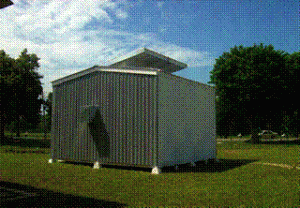Low Energy Architecture
1. Ultra Low Energy House
The Ultra low energy house has various low energy architecture features suitable for the tropical climate condition such as natural ventilation, day lighting and shading. Renewable energy system has been incorporated such as a photovoltaic thermal solar collector for simultaneous production of electricity and hot water.
2. Daylighting Systems and Sky Simulator
A light pipe system using fibre optics for core daylighting has been designed, fabricated and evaluated. The system consists of a collector, transporter and distributor. The compound parabolic collector (CPC) has been chosen for the design as it does not require any mechanical parts to operate it. The CPC has the capability to collect light at any position of the sun’s declination and during any sky condition, and therefore is deemed suitable for the Malaysian sky. The CPC is designed to be fixed to a light pipe that will transport and distribute the light into a building’s interior.
Testing under real skies proves to be very difficult due to the dynamic nature of the sky. Sky simulators are therefore a good substitute for the real sky. The luminance and illuminance produced by the artificial sky can be adjusted to the correct levels during experiments. Sky simulators that have been built around the world are either box-type or domed. A team of local researchers has built a box sky. In addition the team is building a half-dome simulator for more advanced research into innovative daylighting technologies. Such sky simulators are also used for scale modeling at the pre-design stage of daylight buildings. The daylight factor can be obtained by taking the ratio of the readings on the lux meter inside the model building and the lux reading outside of the building.
3. Indoor Air Quality and Thermal comfort Studies
To have “thermal comfort” means that a person wearing a normal layer of clothing feels neither too cold nor too warm. Such comfort is important both for one’s well-being and for productivity in office work, and can be achieved only when the air temperature, humidity and air movement are within the specified range, which is often referred to as the “comfort zone”. Where air movement is virtually absent and when relative humidity can be kept at about 50%, the ambient temperature becomes the most critical and debated factor for maintaining thermal comfort. However, temperature preferences vary greatly among individuals and there is no one temperature that can satisfy everyone. Nevertheless, it is fair to say that an office, which is too warm makes its occupants feel tired. On the other hand, one that is too cold causes the occupants’ attention to drift, making them restless and easily distracted. Workers begin worrying about how to get warm again. Maintaining constant thermal conditions in the offices is important. Even minor deviation from comfort may be stressful and lead to impaired performance and safety. Conversely, workers who are under stress are less tolerant to uncomfortable conditions. Several studies have been conducted including a low energy office and the Istana Istana Lama Muzium Diraja Seri Menanti . The instrument used has the capability of measuring thermal comfort, cross wind ventilation, indoor noise exposure and indoor illumination levels . Other instrument includes an infrared thermometer.
4. Radiative Cooling
Using a building’s roof to take advantage of radiation to the night sky as a heat sink has been long identified as a potentially productive means to reduce space cooling. Radiative cooling to the night sky is based on the principle of heat loss by long-wave radiation from one surface to another body at a lower temperature. In the case of buildings, the cooled surfaces are those of the building shell and the heat sink is the sky since the sky temperature is lower than the temperature of most earth bound objects. Night cooling resource is large and enticing for residential energy-efficiency applications. On a clear night, a typical sky-facing surface at 27°C will cool at a rate of 60W/m2.
View more: Green Innovation Gallery




